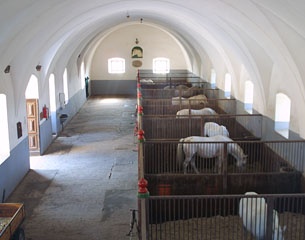
From 12 - 14 October the “Days of European Stud Culture” will be held at Lipica National Stud, Slovenia. The symposium that takes place on Thursday October 13th will be added the following day by a guided stud tour, a performance of the Classical Riding School and the recently opened “Museum Lipikum”, as well as a visit to the World Heritage site of Škocjan in close proximity to the stud.
The symposium will be the kick-off event for the application of the European State Studs for the “European Heritage Label”. The presentations will deal with the wide range of cultural aspects connected with the European state studs. The historic stud premises and cultural landscapes and the living heritage “horse” will be in the focus of attention as well as traditions and knowledge preserved and continued in the national studs over centuries. A special section will deal with ethical issues related to horses and society.
The symposium will be supported by the Slovenian Ministry of Culture. Representatives of national and international heritage organisations and the responsible governmental bodies are expected. Experts from the fields of tangible, intangible and living heritage, as well as representatives of the ESSA partner studs will contribute to the presentations and discussions. All friends of European stud culture invited to join the activities!
More information about the symposium, including the detailed programme and the registration document can be downloaded from www.europeanstatestuds.org.
For centuries horses were bred to match the pattern of human needs: for transport, for agriculture, for military purposes or as partners in sport and leisure. The national and traditional studs of Europe document in a specific and unique way the social development of European history - the horse, as engine and companion, was a factor in the lives of everyone for countless centuries. The historic studs continue to preserve and cultivate the living heritage which is evoked by the powerful term "horse".
With their historic building ensembles and associated cultural landscapes the state studs are of outstanding cultural importance. Yet they have been comparatively little studied and their profile is less high than it should be. The architecture of the studs is characterized by a strong emphasis on functionality while, at the same time, those rulers and others who established the studs gave them an equally strong representative role. The large studs document a special way of life, characterised by the intensive cohabitation of humans and animals. Last but not least, a significant portion of their heritage value lies in the continuity of their use.
Not only the horse itself, but also knowledge of its requirements, its breeding and its formation to fulfill roles in the lives of men, represents immaterial heritage of high significance. Over centuries the state studs managed to preserve traditions and professions that elsewhere have disappeared. They are places of horseman-ship developed and refined over many generations aiming at harmony between men and horse.
The national studs of Europe are important stewards of tradition and history, but they are also modern enterprises and educational institutions. They are living heritage sites, yet with urgent contemporary tasks. They need policies and principles of sustainable development which recognise their traditional values and specific characters. Due to changing ways of life, including social and economic factors, many of these unique institutions were in the past dissolved, strongly limited in their roles or used for purposes other than intended. It is imperative that we reverse these trends in the face of contemporary needs and opportunities.
In 2009 the European State Studs Association (ESSA) has been established to campaign for the preservation of the European State Studs’ cultural heritage. At present 29 partner studs from 13 countries are involved in the networks’ activities.
Related Links
2011 European State Stud Conference at the "Versailles of Horses"
Horses, a European Heritage: Reception and Exhibition at Brussels